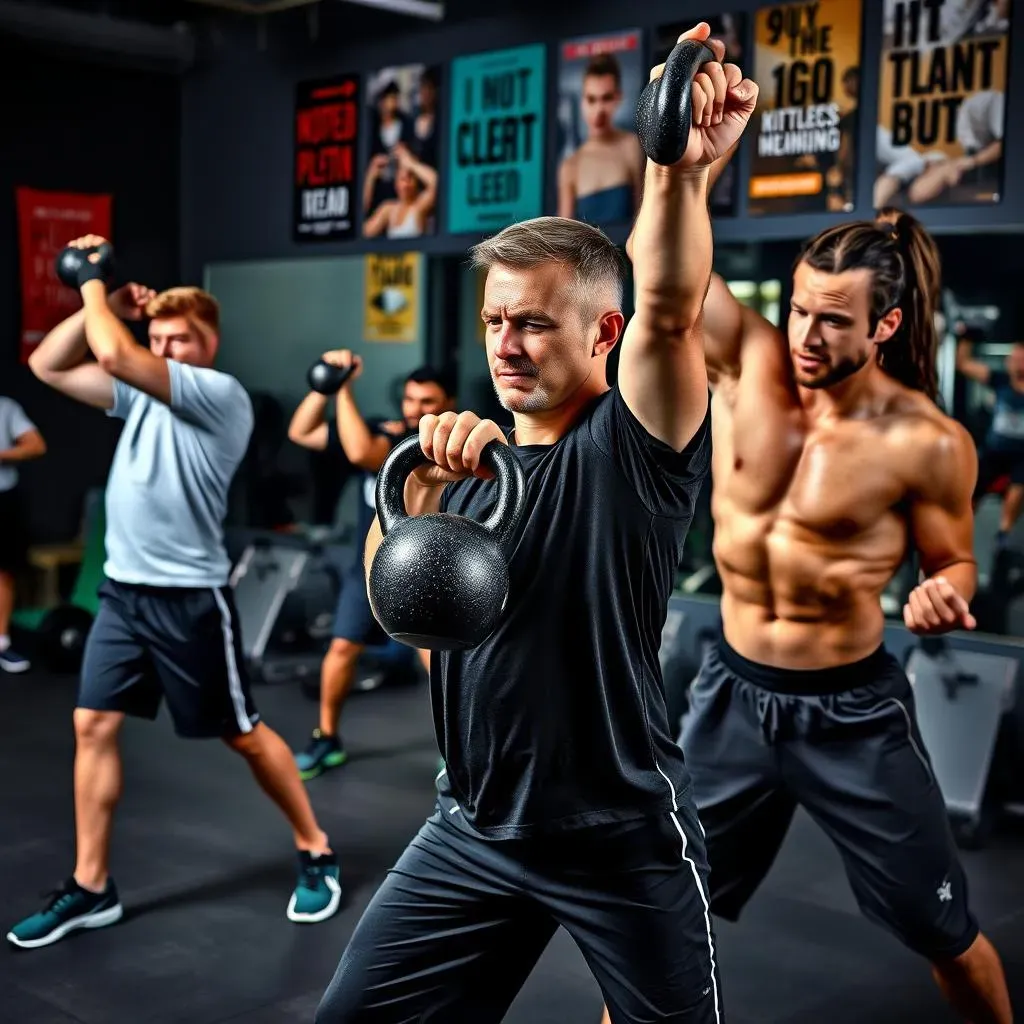Table of Contents
So, you're staring at that kettlebell, ready to unleash some fury, but a nagging question lingers: how long should a kettlebell workout last? It's a valid concern. Nobody wants to waste time on ineffective workouts, but equally, we don't want to overdo it and end up sidelined with aches and pains. The truth is, there's no one-size-fits-all answer. The ideal kettlebell workout duration depends on a bunch of factors, from your fitness goals and experience level to your current energy reserves and the specific exercises you're tackling. Think of it like finding the perfect coffee brew – too short, and it's weak; too long, and it's bitter. This article is your guide to dialing in that perfect kettlebell brew. We'll explore how your goals influence workout length, provide sample workout durations for different levels, share efficiency tips to maximize your time, and most importantly, teach you how to listen to your body and adjust accordingly. Get ready to swing into action, armed with the knowledge to make every minute count!
Finding Your Kettlebell Sweet Spot: Workout Duration Factors

Finding Your Kettlebell Sweet Spot: Workout Duration Factors
so you're ready to swing, but how long should you actually swing for? A ton of things play into finding that perfect workout length. First off, what's your current fitness level? Are you a kettlebell newbie, or are you already tossing around the heavy stuff like it's nothing? Beginners usually benefit from shorter, more frequent sessions to nail down form and avoid overdoing it. Also, think about your goals. Are you trying to build muscle, torch fat, or just improve your overall fitness? Each goal might require a different time commitment. And let's not forget about your schedule. Realistically, how much time can you consistently dedicate to kettlebell workouts each week? It's better to have shorter, regular sessions than infrequent, marathon ones that lead to burnout.
How Long Should a Kettlebell Workout Last for Different Goals?

How Long Should a Kettlebell Workout Last for Different Goals?
so you're wondering how long should a kettlebell workout last, but specifically tailored to what you're trying to achieve, right? Let's break it down. If your main goal is strength gains, you'll want to focus on heavier weights and lower reps, which means more rest time between sets. This naturally extends your workout duration. Think of it as quality over quantity. You might be looking at 45-60 minutes, including a solid warm-up and cool-down. But if fat loss is your game, then you should focus on shorter rest periods and more reps, which keeps your heart rate elevated and torches calories. High-intensity interval training (HIIT) with kettlebells is perfect for this. A 20-30 minute HIIT session can be incredibly effective. And if you're just aiming for general fitness and conditioning, a balanced approach is key. Mix strength and cardio elements, and aim for a moderate duration of around 30-45 minutes.
Now, let's get specific. For strength, consider focusing on compound movements like swings, squats, and presses. Do fewer reps (5-8) with a heavier kettlebell, and rest for 2-3 minutes between sets. This allows your muscles to recover fully so you can hit each set with maximum effort. For fat loss, think circuits. String together exercises like snatches, cleans, and thrusters with minimal rest. This keeps your heart rate up and maximizes calorie burn. Aim for 12-15 reps per exercise, and rest for only 30-60 seconds between circuits. For general fitness, mix it up! Combine strength and cardio exercises in a single workout. Do a set of swings followed by a set of push-ups, then a set of squats. This provides a well-rounded workout that improves both strength and endurance. Remember, these are just guidelines. The most important thing is to listen to your body and adjust the duration and intensity of your workouts accordingly.
Goal | Workout Duration | Focus |
|---|---|---|
Strength | 45-60 minutes | Heavy weights, low reps, long rest |
Fat Loss | 20-30 minutes | HIIT, short rest, high reps |
General Fitness | 30-45 minutes | Balanced strength and cardio |
Sample Kettlebell Workout Durations: Beginner to Advanced

Sample Kettlebell Workout Durations: Beginner to Advanced
Beginner Kettlebell Blast (20-30 minutes)
Alright, newbie kettlebellers, let's start slow and steady. We're talking about building a solid foundation, not throwing yourself into the deep end. A 20-30 minute workout is perfect. Focus on mastering the fundamental movements: the swing, goblet squat, and deadlift. These are your bread and butter. Keep the weight light, and prioritize form over speed or reps. Remember, it's not about how much you lift, but how well you lift it. Think of it as learning to dance – you wouldn't start with a complicated tango, would you? You'd begin with the basic steps.
So, what might a beginner workout look like? Start with a 5-minute warm-up – some light cardio and dynamic stretching. Then, do 3 rounds of the following circuit, resting for 1 minute between rounds:
- Kettlebell swings: 10 reps
- Goblet squats: 8 reps
- Kettlebell deadlifts: 6 reps
Finish with a 5-minute cool-down and some static stretching. And there you have it – a killer beginner workout that won't leave you feeling like you've been hit by a truck.
Intermediate Kettlebell Crusher (30-45 minutes)
you've got the basics down. You're swinging, squatting, and deadlifting like a pro. Now it's time to crank things up a notch. We're talking about increasing the weight, adding more challenging exercises, and pushing your limits. A 30-45 minute workout is the sweet spot. This is where you start to see real results in terms of strength, endurance, and overall fitness. Think of it as leveling up in a video game – you're facing tougher challenges, but you're also unlocking new abilities.
Let's spice things up with some cleans, presses, and rows. These exercises will challenge your muscles in new ways and help you build a more well-rounded physique. Try this workout, after a good warm up:
- Kettlebell cleans: 3 sets of 8 reps per arm
- Kettlebell presses: 3 sets of 6 reps per arm
- Kettlebell rows: 3 sets of 10 reps per arm
- Kettlebell swings: 3 sets of 15 reps
Rest for 1-2 minutes between sets. Don't forget to cool down and stretch afterwards.
Advanced Kettlebell Annihilation (45-60 minutes)
Alright, you absolute kettlebell beasts, this is where things get serious. You're a seasoned pro, hungry for a challenge. We're talking about pushing your body to its absolute limits. A 45-60 minute workout is your playground. This is where you unleash your inner beast and transform yourself into a kettlebell-wielding machine. Time to add in the big guns: snatches, Turkish get-ups, and windmills. These exercises are not for the faint of heart. They require a high level of skill, strength, and coordination. But the rewards are immense.
Before you dive into advanced kettlebell exercises, make sure you have mastered the fundamental movements and have a solid foundation of strength and conditioning. If you're unsure, consult with a qualified kettlebell instructor. Here’s a sample routine:
Exercise | Sets | Reps | Rest |
|---|---|---|---|
Turkish Get-Ups | 3 | 1-3 per side | 2-3 minutes |
Snatches | 3 | 5-8 per side | 1-2 minutes |
Windmills | 3 | 5-8 per side | 1-2 minutes |
Maximizing Your Kettlebell Workout Time: Efficiency Tips

Maximizing Your Kettlebell Workout Time: Efficiency Tips
Alright, so you're juggling life, work, and trying to squeeze in a kettlebell session? I get it. Time is precious. The good news is, you can absolutely maximize your kettlebell workout time with a few smart strategies. First, ditch the excessive rest periods. Unless you're specifically training for strength with heavy weights, keep your rest to a minimum. Think 30-60 seconds between sets, tops. This keeps your heart rate elevated and torches more calories in less time. Second, embrace compound exercises. These are your multi-joint movements that work multiple muscle groups simultaneously. Swings, cleans, snatches, and thrusters are your best friends here. They give you the most bang for your buck.
Another tip is to plan your workouts in advance. Don't just wander into your workout space and wing it. Have a clear idea of what exercises you're going to do, how many sets and reps, and how long you're going to rest. This eliminates wasted time and keeps you focused. And finally, consider circuit training. This involves performing a series of exercises back-to-back with minimal rest, then repeating the circuit several times. It's a super-efficient way to get a full-body workout in a short amount of time.
Here's a quick rundown of efficiency boosters:
- Minimize Rest: Keep it under 60 seconds unless strength training.
- Compound Movements: Swings, cleans, snatches for full-body impact.
- Plan Ahead: Know your workout before you start.
- Circuit Training: Maximize calorie burn and muscle engagement.
Listen to Your Body: Adjusting Your Kettlebell Workout Length

Listen to Your Body: Adjusting Your Kettlebell Workout Length
Know Your Signals: Recognizing Fatigue
Alright, let's talk about the most important piece of the puzzle: your body. Forget what the internet says, forget what your gym buddy is doing. How long should a kettlebell workout last for YOU? The answer lies in tuning in to your body's signals. Are you feeling genuinely tired, or are you pushing through legitimate pain? There's a huge difference. Fatigue is normal – it's that feeling of your muscles burning, your breath getting heavier, and your energy reserves starting to dip. Pain, on the other hand, is a sharp, persistent sensation that tells you something is wrong. Ignoring pain is a surefire way to end up injured and sidelined. Learn to distinguish between the two, and respect the warning signs.
Think of it like driving a car. Fatigue is like your fuel gauge getting low – you know you need to refuel soon. Pain is like your engine making a weird noise – you need to pull over and get it checked out. Don't be a hero. If you're feeling pain, stop what you're doing and address it. That might mean adjusting your form, reducing the weight, or simply calling it a day.
The Art of Auto-Regulation: Adjusting on the Fly
So, you're mid-workout, and you're starting to feel that fatigue creeping in. What do you do? This is where the art of auto-regulation comes in. It's all about adjusting your workout on the fly based on how you're feeling. Maybe you planned on doing 5 sets of swings, but after 3, your form is starting to break down. Don't force it! Reduce the number of sets, decrease the weight, or switch to an easier exercise. The goal is to maintain good form and avoid injury, even if it means modifying your original plan.
Think of auto-regulation as being your own coach. You're constantly monitoring your body's feedback and making adjustments as needed. It takes practice, but it's a crucial skill for long-term success. Don't be afraid to experiment. Try different techniques, like reducing the number of reps per set, increasing the rest time, or swapping out a challenging exercise for an easier one. The key is to find what works best for you on any given day.
Signal | Possible Adjustment |
|---|---|
Form Breakdown | Reduce weight, decrease reps, switch to easier exercise |
Excessive Fatigue | Increase rest, shorten workout, reduce sets |
Joint Pain | Stop exercise, adjust form, consult professional |
Long-Term Trends: Tracking Progress and Adapting
It's not just about what's happening in a single workout, it's about looking at the bigger picture. Keep a workout journal or use a fitness app to track your progress over time. This will help you identify patterns and trends in your performance. Are you consistently feeling fatigued after a certain amount of time? Maybe you need to shorten your workouts. Are you consistently crushing your workouts without feeling challenged? Time to ramp things up!
Tracking your progress allows you to make informed decisions about your training. It's not just about blindly following a program, it's about understanding how your body responds to different stimuli and adjusting accordingly. Are you sleeping poorly? Are you stressed at work? All of these factors can impact your energy levels and your ability to recover. Don't be afraid to take a rest day when you need it. Overtraining is a real thing, and it can lead to burnout, injury, and decreased performance. Remember, consistency is key, but consistency doesn't mean pushing yourself to the limit every single day. It means finding a sustainable balance that allows you to train hard, recover properly, and enjoy the process.
Swinging Towards Success: Finding Your Ideal Kettlebell Workout Length
Ultimately, figuring out how long your kettlebell workout should last is a personal journey. There's no magic number, but by understanding the factors that influence workout duration – your goals, experience, and how your body responds – you can craft a routine that's both effective and sustainable. Don't be afraid to experiment, adjust, and most importantly, listen to your body. Consistency is key, so find a workout length that you can realistically maintain over the long haul. Now go forth, swing those bells, and reap the rewards of a well-planned, perfectly timed kettlebell workout!